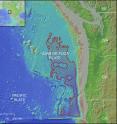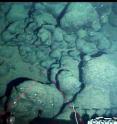Undersea volcanic rocks offer vast repository for greenhouse gas, says study
Related images
(click to enlarge)
A group of scientists has used deep ocean-floor drilling and experiments to show that volcanic rocks off the West Coast and elsewhere might be used to securely imprison huge amounts of globe-warming carbon dioxide captured from power plants or other sources. In particular, they say that natural chemical reactions under 78,000 square kilometers (30,000 square miles) of ocean floor off California, Oregon, Washington and British Columbia could lock in as much as 150 years of U.S. CO2 production. The findings are published today in the Proceedings of the National Academy of Sciences. Interest in so-called carbon sequestration is growing worldwide. However, no large-scale projects are yet off the ground, and other geological settings could be problematic. For instance, the petroleum industry has been pumping CO2 into voids left by old oil wells on a small scale, but some fear that these might eventually leak, putting gas back into the air and possibly endangering people nearby.
Lead author David Goldberg, a geophysicist at Columbia University's Lamont-Doherty Earth Observatory, called the study "the first good evidence that this kind of carbon burial is feasible."
"We are convinced that the sub-ocean floor is a significant part of the solution to the global climate problem," said Goldberg. "Basalt reservoirs are understudied. They are immense, accessible and well sealed--a huge prize in the search for viable options." One of the main advantages, he said, is a chemical process between basalt and pumped-in CO2 that would convert the carbon into a solid mineral.
In their paper, Goldberg and his colleagues Taro Takahashi and Angela Slagle used previous deep-ocean drilling studies of the Juan de Fuca plate, some 100 miles off the Pacific coast, to chart a vast basalt formation that they say could be suitable for such pumping. Basalt, the basic stuff of the ocean floors, is hardened lava erupted from undersea fissures and volcanoes. In this region, much of it lies under some 2,700 meters (8,850 feet) of water, and 200 meters (650 feet) or more of overlying fine-grained sediment. Drilling by the Integrated Ocean Drilling Program has shown the rock is honeycombed with watery channels and pores that would provide room for pressurized CO2. The scientists have mapped out specific areas that they say are isolated from earthquakes, hydrothermal vents or other factors that might upset the system.
Ongoing experiments by Lamont scientists on land have shown that when CO2 is combined with basalt, the gas and components of the rock naturally react to create a solid carbonate—basically, chalk. Later this year, a separate team headed by Lamont geochemist Juerg Matter will begin pumping CO2 into a landbound basalt formation at a power plant near Reykjavik, Iceland—the first such large-scale demonstration. Basalts lie at or near the surfaces of other land areas including the northeast United States; the Caribbean; north and south Africa; and southeast Asia.
Goldberg says that undersea basalts, which are widespread, may be bigger, and better, than ones on land. At the depths studied, any CO2 that does not react with the rock will be heavier than seawater, and thus unable to rise. And in places like the Juan de Fuca, even if some did escape the rock, it would hit the overlying impermeable cap of clayey sediment.
Skeptics point out that getting the CO2 to such sites could be expensive and tricky. But Goldberg says the West Coast formations should be close enough to the land for delivery by pipelines or tankers. He called on government to study the details of how the idea might work, and whether it would be economically feasible. The United States currently spends about $40 million a year studying carbon sequestration, but nearly all of that goes to land-based research. "Forty million is about the opening-day box office for Finding Nemo," said Goldberg. We need policy change now, to energize research beyond our coastlines."
Source: The Earth Institute at Columbia University
Other sources
- Undersea Volcanic Rocks Offer Vast Repository For Greenhouse Gas, Says Studyfrom Science DailyTue, 15 Jul 2008, 1:21:27 UTC
- Undersea volcanic rock could house greenhouse gases, scientists sayfrom CBC: Technology & ScienceMon, 14 Jul 2008, 22:21:04 UTC
- Answer to Carbon Emissions May Lie Under the Seafrom Science NOWMon, 14 Jul 2008, 22:07:04 UTC
- Undersea volcanic rocks offer vast repository for greenhouse gas, says studyfrom PhysorgMon, 14 Jul 2008, 21:42:10 UTC
- Out of Sight, Out of Clime: Burying Carbon In a Vault of Sea and Rock [News]from Scientific AmericanMon, 14 Jul 2008, 21:14:08 UTC

